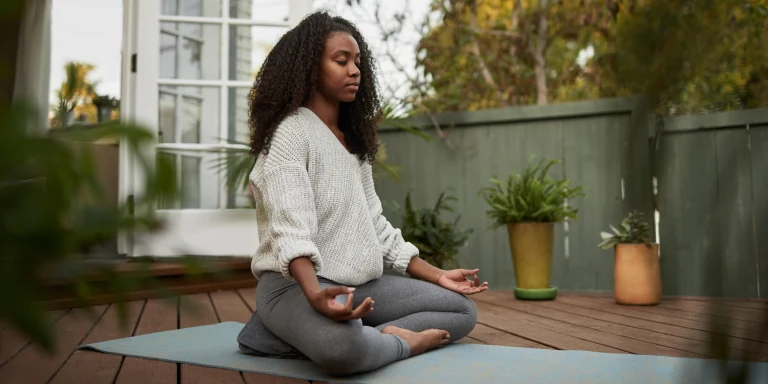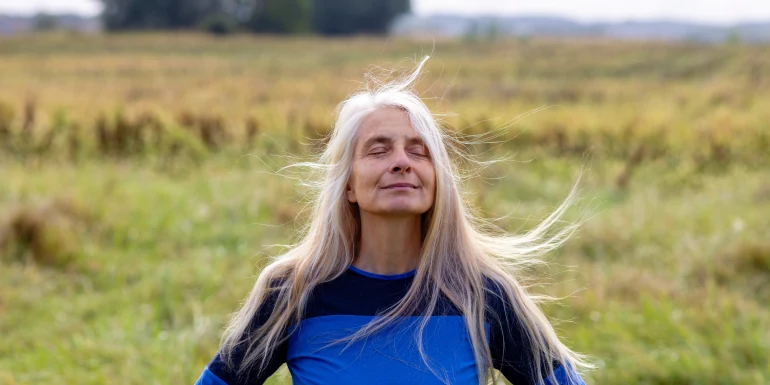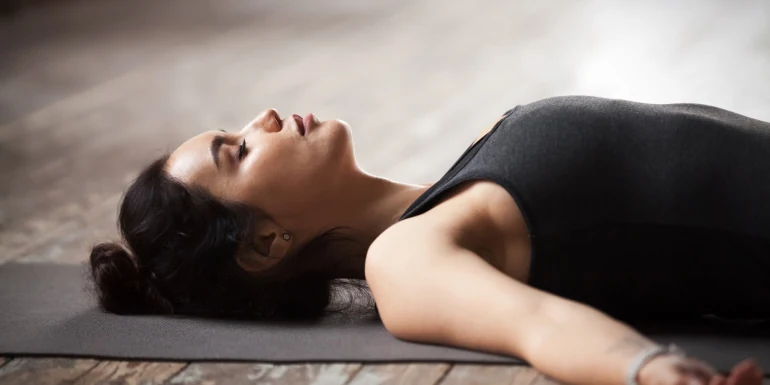
Meditation made easy
Meditation dates back millennia and allows you to unwind through mindfulness and concentration exercises. Why is meditation worthwhile? How can I learn to meditate? Here’s a meditation for beginners in eight steps, with tips from our expert.
Meditation helps you deeply relax from head to toe. It’s a kind of mental training, alleviating stress and anxiety, and reducing negative thoughts.
Meditation has long been a scientifically recognised relaxation technique like autogenic training, yoga and mindfulness methods such as MBSR (mindfulness-based stress reduction), and it doesn’t need to be about spirituality.
Learn to meditate: a guide for beginners
When you first start, it will take patience and practice to achieve stillness. Keep going anyway, and it will become a routine. Your body will get more used to being still and it will soon become second nature. This eight-step meditation guide is here to help you.
- Choose a quiet place
Ensure that you won’t be disturbed. Not by people, background noises or your phone. - Wear warm, comfortable clothing
When you’re sitting still, you quickly cool down. Make sure you wear loose and warm clothing, possibly a scarf around your shoulders and thick socks. - Find a comfortable, seated position
Whether you’re sitting on a chair, standing, lying down or in the lotus yoga position, you need to feel at ease. A cushion, blanket or chair can help you to remain stable yet relaxed. - Hold your body upright
Straighten your spine, tilt your chin slightly towards your chest, relax your shoulders and allow them to fall backwards. Gently let your hands rest on your knees or on your lap. You can now breathe freely. - Set an alarm
Start with short meditations. Begin with five-minute sessions and slowly build up to ten minutes at your own pace. You could also take a mindful break and then continue meditating for another few minutes. This hones your awareness even more and over time, it’ll get easier to meditate for longer periods. - Start meditating: Observe your breathing
When meditating, your breathing helps stabilise your restless mind and allows you to reach a state of calm. Our mind is constantly at play, looking both forward and back. If you find it hard to stay with the breath, focus your attention on your body, moving from one part to the next. Imagine that you’re letting go of muscle tension in each place. After you let go, consciously feel into that part of your body and observe any sensations that are there. Once you’ve moved through each part of your body, broaden your awareness to your entire body. Try to let go and notice how your body responds. - Let go of your thoughts
Accept the thoughts that come into your mind but don’t get hung up on them. You are simply an observer, meaning you should accept your thoughts and let them glide past like clouds in the sky. Or you could imagine that you’re standing at a station and your thoughts are like trains moving away. - Finish the meditation: slowly bring your awareness back to your body.
Don’t leap up straight away. Give yourself a few more minutes. Have a stretch and take a couple of deep breaths. Open your eyes and slowly get up. Maybe drink your favourite tea (which you’ve already prepared) or look out the window. Now you’re ready to face the day ahead.
You’ll find simple meditation exercises from beginner to advanced in the free Helsana Coach app. Guided audio instructions help you leave your stress behind and relax. Anywhere, any time, and as often as you like.
Learn tips and tricks for meditating
You have hardly sat down and your thoughts are already running wild. Do your legs and feet go to sleep? This is completely normal. Be patient with yourself and try out the following tips:
Position a neutral object approx. one metre in front of you on the floor and observe it while you consciously pay attention to your breathing and count your breaths. To begin with, your mind might already start to stray at seven breaths. Your concentration will improve. You could also try progressive muscle relaxation, a practice based on tensing and relaxing your muscles. It is less challenging in terms of sustaining focus and concentration.
Try a different seated position – one that’s comfortable even after ten minutes. You can also try sitting on a chair just as you normally do or lying down. Or change your position partway through the meditation. You may also get tingling in your legs if you’re wearing close-fitting clothes.
Trying to stop all thinking won’t work. Let your mind be free. Accept each thought and emotion as it comes. If you fight against it, the thought or emotion only gets stronger. Simply observe it, and then let it go.
The ideal time to meditate is in the morning, when your mind is still fresh. But not everyone is a morning person. Maybe it fits in better with your evening rituals? The time of day doesn’t matter, however. What’s important is regular practice. Make meditation part of your daily routine. Then it will soon become a habit. Your mind and body will automatically associate the time and place with a relaxed, meditative state.
Looking for quick results? Don’t expect too much. Learning to meditate is like learning to play an instrument. If you only practise once a week, you’ll progress much more slowly than through daily practice. If you sometimes don’t feel that motivated, it’s better to practise briefly than not at all.
Learn different meditation techniques
Meditation doesn’t have to be passive. There are also active forms involving sitting, walking, talking, or with music – give it a try!
- Walking meditation: walking with awareness
- Mindful breathing: using different breathing techniques
- Affirmations: using positive statements
- Visualisation: focusing on an object
- Body scan: a journey of awareness through all parts of your body
- Mantras: repeating a certain word, sentence or sound like “Om”
- Sound meditation: accompanied by sounds from special instruments
- Awareness meditation: MBSR mindfulness training and interoceptive awareness®
Learn to meditate through a course or alone, or with help from the Helsana Coach app.
What does Helsana pay for?
How meditation helps
Meditation and mindfulness exercises have a positive effect on our whole body. They allow us to deal better with stress and to experience inner peace and equilibrium. These mental factors in turn influence our physical health, including our blood pressure, immune system and cholesterol level.
Various neuroscientific studies show how meditation and mindfulness exercises actually change our brain activity and structure. They help people deal better with stress, improve cognitive performance; alleviate depression, anxiety, sleep problems and pain; strengthen the immune system and cardiovascular system, and generally improve well-being.
Had enough theory? Then it’s high time for your first meditation practice. In other words, let’s get started. Happy meditating!

Sandra Schwendener (work psychologist, certified stress management trainer, specialist in medical progressive muscle relaxation and mindfulness interoception® SGMEV ad interim) has worked at Helsana since 2016. As a specialist in occupational health management, she helps people cope with stress, learn relaxation techniques and establish a good work-life balance. She offered advice and input for this article.
.hlsimg.2_1.w770.jpg)


Newsletter
Find out more about current health issues every month and get all the information you need about our attractive offers from all Helsana Group companies * delivered by e-mail to read whenever it suits you. Our newsletter is free of charge and you can sign up here:
We did not receive your information. Please try again later.
* The Helsana Group comprises Helsana Insurance Company Ltd, Helsana Supplementary Insurances Ltd and Helsana Accidents Ltd.